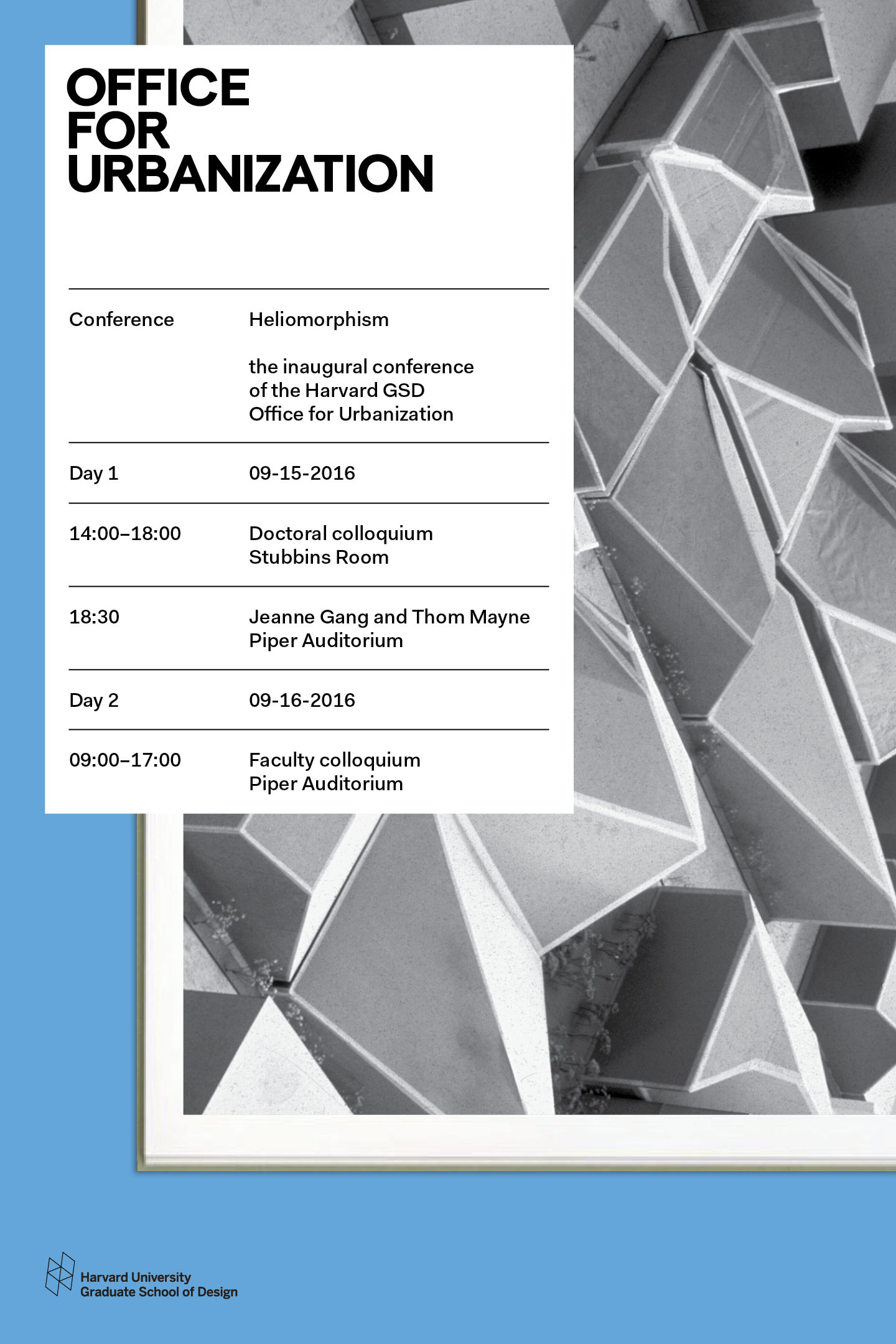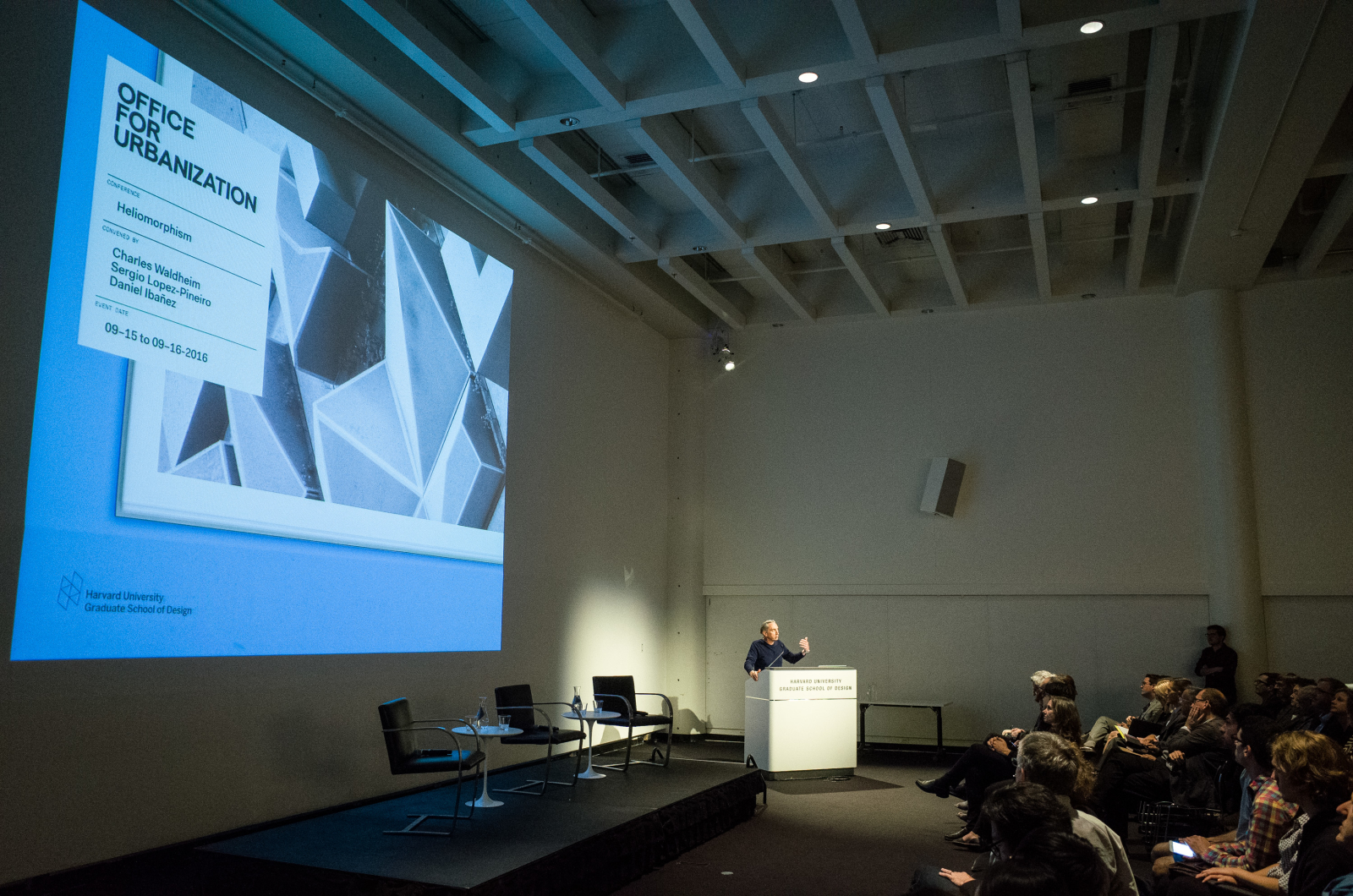Inaugural Conference of the Harvard GSD Office for Urbanization: “heliomorphism”

Convened by Charles Waldheim with Sergio Lopez-Pineiro and Daniel Ibañez
View program online
Download program as PDF file
The topic of solar orientation and urban form is both perennial and, once again, timely. The discourses and practices of ‘ecological urbanism’ have turned our focus to the terrestrial topics of hydrological connectivity and ecological function. Heliomorphism proposes to revise and extend the ecological urbanism agenda by returning to solar performance. Recent projects by a number of leading architects and urbanists have suggested new forms of urban order through solar orientation. In many of these projects, designers correlate the shape of the city to a complex and contradictory economy of solar performance.
The topics of solar orientation and social order, public health, and political economy were fundamental questions for many protagonists and projects of modern planning. In the wake of the collapse of modern planning, singular models of social urban order based on latitude and solar equity have given way to neoliberal models of market driven urbanization. The inaugural conference of the Harvard GSD Office for Urbanization returns to this archaic aspect of urban order, and convenes an international group of GSD faculty and doctoral candidates, as well as a select group of GSD alumni to examine its present potentials through three discursive frames: plug-ins, commons, and zero-sum.
plug-ins
Ralph Knowles’s concept of the ‘solar envelope’ proposed a design tool that anticipates contemporary interests in parametricism and relational modeling. The envelope offered a projective form through which urban morphology was indexed to solar performance. The technological developments of the last decade have enabled an unanticipated degree of precision and feedback, potentially infusing new possibilities into an idea that has a half-century of history. Plug-ins revisits the changes, conceptual and projective, that contemporary models of computational geometry have brought to this design model.
commons
Independent of location or latitude, access to the sun is considered an ancient and inviolable right in many cultures. Several current politico economic conceptions, however, protect it for health considerations while others regulate it for energy reasons. Regardless of these two distinctions, commons reconsiders both types of solar access to be issues of social equity and it examines, accordingly, the tensions that exist between built form through capital accumulation and access to sunlight through environmental consensus.
zero-sum
The energy crisis and economic shocks of the 1970s led to experimental and counter-culture practices of architecture and urbanism. These practices enabled the emergence of domestic applications and DIY methods of implementation in a new political economy of solar energy. The current environmental crisis embraces zero-carbon responses and has pushed the scale of operation to neoliberal corporate and governmental urbanizations. Zero-sum reviews the shifts from the domestic to the urban, from the individual to the conglomerate (political or economical), from the alternative to the new normal.
Thursday, September 15, 2016
Stubbins Room
doctoral colloquium
14:15 introductions
Charles Waldheim and Daniel Ibañez
14:45 plug-ins
Mariano Gómez Luque, Shadows in New York: The Spatial Formulas of Financial Manhattanism
Arta Yazdanseta, Density vs. the Ethics of the Solar Envelope: A Case Study
Response by John Davis
15:30 break
15:45 commons
Miguel López Melendez, Ludwig Hilberseimer’s Organic Principle as a Reconciliation of Urban Form with Itself
Nicole Beattie, Design Responsibility in Human Health: An Analysis of Sunlight Use in Social Housing in Chile
Ateya Khorakiwala, The 1978 Sun Congress: Exploring the Technopolitics of Solar Architecture in the Third World
Response by Adam Tanaka
16:45 break
17:00 zero-sum
Daniel Daou, Energetic Determinisms: From Heliobiology to Thermosemiosis
Aleksandra Jaeschke, Non-zero-sum Net-zero codes
Response by Justin Stern
17:45 conclusions
Ed Eigen and Helen Kongsgaard
Harvard GSD, Piper Auditorium
18:30 introductions
Mohsen Mostafavi and Charles Waldheim
keynotes
Jeanne Gang, Studio Gang
Thom Mayne, Morphosis
Friday, September 16, 2016
Piper Auditorium
09:15 introductions
Charles Waldheim and Sergio Lopez-Pineiro
09:45 project
Mariana Ibañez, Lights On
10:15 plug-ins
Andrew Witt, The Heuristic Ecology of Heliomorphism
Holly Samuelson, Using Parametric Simulation to Design for Future Contexts
Andres Sevtsuk, Balancing Urban Form: the Means, the Ends and the Tools
Silvia Benedito, On (de)light
Hosted by Florian Idenburg
11:30 project
Eric Howeler, Adaptive Architectures
12:00 lunch
13:00 commons
Eve Blau, Heliomorphism and the Production of Socialist Space
Salmaan Craig, The Thermal Resonance of Buildings
Leire Asensio and David Mah, Fabrications
Sergio Lopez-Pineiro, Heliomorphic Urban Space
Hosted by Carles Muro
14:15 project
Scott Cohen, Density and Reflection
14:45 break
15:00 zero-sum
Felipe Correa, Sun from the North: Enrico Tedeschi and a Cosmic Architecture
Elizabeth Whittaker, Solar Driven: Interventions in Form(al) and Surface Typologies
Francesca Benedetto, Amazing Sun
Camilo Restrepo Ochoa, Parasol
Hosted by Ashley Schafer
16:15 keynote
Iñaki Ábalos, False Friends
Illustration: Ralph Knowles, “Solar Envelope,” 1981.
Anyone requiring accessibility accommodations should contact the Public Programs Office at (617) 496-2414 or [email protected].
#GSDEVENTS


